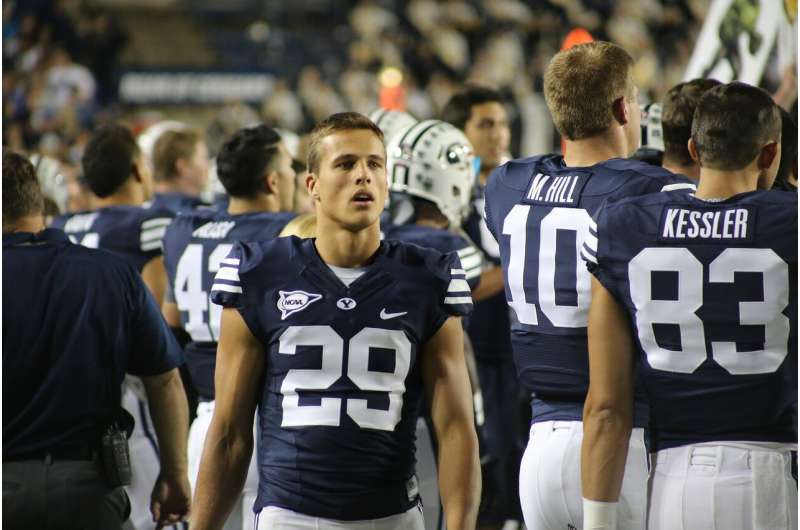High school sports are losing athletes to private clubs, but schools can keep them by focusing on character development

Not long ago, high school students who wanted to play football, basketball or another sport had few options other than . And it was to high school gymnasiums and fields that recruiters flocked to find talent for colleges and even the pros.
That's changed in recent decades as and soared in popularity across the country. Today, kids interested in pretty much any sport often instead of playing on their high school's varsity squads. Clubs have been especially good at due to their intense and competitive nature.
As a result, parents are increasingly debating something that would have been unthinkable a couple of generations ago: Where should our kids play sports?
As a —and as a current parent of three youth athletes from elementary to the collegiate level—I know it can be a tough choice. I've seen firsthand the of playing sports both in high school and clubs.
While clubs may be best for the most talented athletes, schools can't be beat for the broader focus they can put on character development. Since the vast majority of student-athletes won't play in organized leagues beyond high school, that's where I believe the schools' focus should be.
My own unpublished research shows it's also a way—along with emphasizing the fun and social aspects of athletics—to get more students who played sports as young kids to continue in high school.
The rise of the private youth sports industry
Although I am an for school-based athletics, I recognize or private-league programs.
But prior to the 1980s, private clubs weren't common. Before high school, kids played on teams organized by their schools, local parks and recreation programs or nonprofit organizations such as the YMCA. After that, the only option for most was high school sports.
The first big step toward highly organized, privatized youth sports programs occurred during what has been referred to as "the Reagan revolution," according to . President Ronald Reagan's funding cuts across the government pushed more expenses onto states and cities, which of local parks and recreation departments to fully staff youth programs. This left many of them with only enough funds to maintain their facilities.
At the same time, school districts began systematically offered in lieu of an increased focus on subjects such as math and science. Those two factors took away the most for for many families.
With the reduction of public offerings, the youth sports programming gap was filled by private clubs and leagues, which placed more emphasis on athleticism, competition and sometimes elite-style training. And it's become big business for the adults who run these programs.
While good numbers on these leagues are hard to come by, multiple data sources show the privatized youth sports market has experienced tremendous growth in recent years. A total spending on youth sports at over US$40 billion as of 2024, compared with the of the youth sports economy in 2010.
But despite their growth, one sobering statistic for aspiring elite athletes remains true: will advance to the collegiate level or beyond.
Knowing that 93% of high school athletes will end their competitive careers at graduation, I believe it's important that school administrators place a premium on running athletic programs that focus on building skills they'll need as adults instead of just winning games.
Why most students play
My own research backs this up.
In my previous role as a director of athletics for public schools in Grand Forks, North Dakota, I routinely surveyed our athletes at the end of their seasons about various aspects of their experience on the team. Among those questions, I asked athletes to tell me the three most important reasons they chose to play that sport for that season and whether they were planning to play on the team again next year.
Unsurprisingly to me, the top three reasons were consistently to have fun, spend time with friends and stay physically active, in that order. You'll notice winning games or for competition were not among them.
On the flip side, when asked why students chose to drop out the following year, the top reason was their relationship with the coach, while a close second was that they were not having fun. To me, this was evidence that what student-athletes most wanted from their high school programs wasn't so much sport skills development as personal development and growth.
Other studies back this up. Overtraining and a lack of fun are cited as the main reasons why 70% of young athletes who compete on a team .
Focus on the fun—not the competition
Here are five things school administrators can do to help turn things around and make their sports programs more attractive to students considering clubs, as well as those who are pondering giving up on sports altogether.
- Develop an athletic program that teaches character traits and life skills that are usable for 100% of participants, not just the 7% who go on to play in college.
- Make sure programs emphasize fun, social growth and physical fitness, rather than just the competition.
- Encourage coaches to spend individual time throughout the season with each student-athlete to discuss the athlete's goals, role and progress.
- Survey student-athletes about their experience at the end of each season and tweak the program accordingly.
- Include student-athlete assessments about how much they enjoy playing for the coach as a part of the coach's postseason evaluation.
High school sports may not be for everybody, but I believe many more students would choose to participate if the focus were on building character and having fun with friends, not winning trophies.
Provided by The Conversation
This article is republished from under a Creative Commons license. Read the .![]()
















